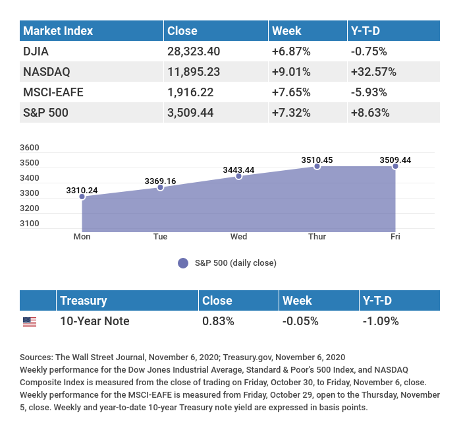In this week’s recap: Markets react positively to the election, seeing promise in a divided government; unemployment rate falls.
Weekly Economic Update
Presented by Craig Moore, November 9, 2020
THE WEEK ON WALL STREET
Stocks soared last week as investors anticipated that a split Congress would raise legislative hurdles to changing corporate taxes and adjusting regulatory oversight of big technology companies.
The Dow Jones Industrial Average jumped 6.87%, while the Standard & Poor’s 500 tacked on 7.32%. The Nasdaq Composite index surged 9.01% for the week. The MSCI EAFE index, which tracks developed overseas stock markets, rose 7.65%.1,2,3
Bulls Take Charge
Coming off a poor close to October, stocks surged throughout election week, jumping higher in pre-election trading on bargain hunting and strong factory activity. The rally picked up steam as Americans went to the polls and shifted into overdrive Wednesday morning.
Investors were buoyed by Congressional results that indicate that the next president would have to work with a divided Congress. Though a divided Congress might result in a smaller potential stimulus package and continued gridlock, investors seemed to believe that was outweighed by a diminished risk of higher taxes, greater regulation, and policy initiatives that might be challenging to businesses.
Stocks took a pause to close out the week, even as a solid jobs report saw the unemployment rate fall a full percentage point to 6.9%.4
Yields Gyrate
Overlooked amid the powerful rally in stock prices was the swing in yields last week. Action in the bond market is important since 10-year Treasury yields are a benchmark for setting borrowing costs for businesses and they represent another view on the strength of the economic recovery.
The 10-year Treasury note rose as high as 0.942% during after-hours trading on election evening and dropped to 0.768% by the end of normal trading hours on Wednesday.5
T I P O F T H E W E E K
If you are presently retiring, moving, or divorcing, try tracking all your expenses for the next few weeks or months. Big life changes like these may mean big revisions to your budget.
THE WEEK AHEAD: KEY ECONOMIC DATA
Thursday: Consumer Price Index (CPI), Jobless Claims.
Friday: Consumer Sentiment.
Source: Econoday, November 6, 2020
The Econoday economic calendar lists upcoming U.S. economic data releases (including key economic indicators), Federal Reserve policy meetings, and speaking engagements of Federal Reserve officials. The content is developed from sources believed to be providing accurate information. The forecasts or forward-looking statements are based on assumptions and may not materialize. The forecasts also are subject to revision.
THE WEEK AHEAD: COMPANIES REPORTING EARNINGS
Monday: McDonald’s Corporation (MCD), Simon Property (SPG).
Tuesday: D.R. Horton (DHI), Rockwell Automation (ROK), Datadog, Inc. (DDOG).
Wednesday: Air Products and Chemicals, Inc. (APD).
Thursday: Tencent Holdings (TCEHY), The Walt Disney Company (DIS), Cisco Systems (CSCO), Applied Materials (AMAT).
Friday: Draftkings, Inc. (DKNG).
Source: Zacks, November 6, 2020
Companies mentioned are for informational purposes only. It should not be considered a solicitation for the purchase or sale of the securities. Investing involves risks, and investment decisions should be based on your own goals, time horizon, and tolerance for risk. The return and principal value of investments will fluctuate as market conditions change. When sold, investments may be worth more or less than their original cost. Companies may reschedule when they report earnings without notice.
Q U O T E O F T H E W E E K
“Nothing in life is to be feared. It is only to be understood.”
MARIE CURIE

T H E W E E K L Y R I D D L E
Two-and-a-half artists spend two-and-a-half hours painting two-and-a-half models on two-and-a-half canvases. How many artists would be necessary to paint 24 models on 24 canvases in 20 hours?
LAST WEEK’S RIDDLE: Is there a number made of eleven tens of thousands, eleven thousands, eleven hundreds, and eleven units? If so, what is it?
ANSWER: Yes – the number is 122,111. 110,000 + 11,000 + 1,100 + 11 = 122,111.
Investing involves risks, and investment decisions should be based on your own goals, time horizon, and tolerance for risk. The return and principal value of investments will fluctuate as market conditions change. When sold, investments may be worth more or less than their original cost.
The forecasts or forward-looking statements are based on assumptions, may not materialize, and are subject to revision without notice.
The market indexes discussed are unmanaged, and generally, considered representative of their respective markets. Index performance is not indicative of the past performance of a particular investment. Indexes do not incur management fees, costs, and expenses. Individuals cannot directly invest in unmanaged indexes. Past performance does not guarantee future results.
The Dow Jones Industrial Average is an unmanaged index that is generally considered representative of large-capitalization companies on the U.S. stock market. Nasdaq Composite is an index of the common stocks and similar securities listed on the Nasdaq stock market and is considered a broad indicator of the performance of technology and growth companies. The MSCI EAFE Index was created by Morgan Stanley Capital International (MSCI) and serves as a benchmark of the performance of major international equity markets, as represented by 21 major MSCI indexes from Europe, Australia, and Southeast Asia. The S&P 500 Composite Index is an unmanaged group of securities that are considered to be representative of the stock market in general.
U.S. Treasury Notes are guaranteed by the federal government as to the timely payment of principal and interest. However, if you sell a Treasury Note prior to maturity, it may be worth more or less than the original price paid. Fixed income investments are subject to various risks including changes in interest rates, credit quality, inflation risk, market valuations, prepayments, corporate events, tax ramifications and other factors.
International investments carry additional risks, which include differences in financial reporting standards, currency exchange rates, political risks unique to a specific country, foreign taxes and regulations, and the potential for illiquid markets. These factors may result in greater share price volatility.
Please consult your financial professional for additional information.
This content is developed from sources believed to be providing accurate information. The information in this material is not intended as tax or legal advice. Please consult legal or tax professionals for specific information regarding your individual situation. This material was developed and produced by FMG Suite to provide information on a topic that may be of interest. FMG is not affiliated with the named representative, financial professional, Registered Investment Advisor, Broker-Dealer, nor state- or SEC-registered investment advisory firm. The opinions expressed and material provided are for general information, and they should not be considered a solicitation for the purchase or sale of any security.
Copyright 2020 FMG Suite.
CITATIONS:
- The Wall Street Journal, November 6, 2020
- The Wall Street Journal, November 6, 2020
- The Wall Street Journal, November 6, 2020
- The Wall Street Journal, November 6, 2020
- The Wall Street Journal, November 5, 2020
